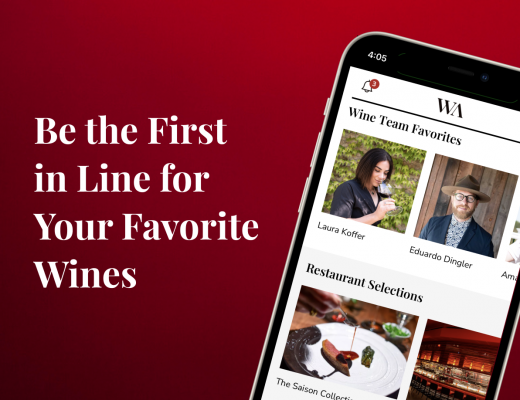By Courtney Schiessl
Since Covid-19 forced states across the U.S. to enact shelter-in-place mandates in March, there have been plenty of negative things to dwell on. After all, everyday norms have been upended: Offices were abandoned, weekend get-togethers became a thing of the past, and favorite restaurants and bars were shuttered overnight.
But there have been unexpected positives to shelter-in-place as well, from more time with family to saving money on the daily commute. While this period of staying home and social distancing has separated foodies from their regular restaurants, it has also transformed the way they approach dining and drinking at home for the better.
Without the ability to treat themselves to the chef’s special or pore over a wine list for the perfect bottle, food and wine lovers are creating special culinary experiences for themselves—and realizing that they have never had more access to specialty ingredients, multicourse meals, and world-class wines.
“There is a desire to want to recreate the restaurant experience,” says Jon McDaniel, a Chicago-based sommelier and the CEO of wine consulting firm Second City Soil, “which absolutely allows for inclusion of better wine and more focused pairing of great wine with better recipes and food items.” Judging by sales numbers alone, most Americans have deemed wine to be a necessity; according to Nielsen, retail alcohol sales were up 26.8 percent year-over-year for the 12-week timeframe ending May 23.
Even as avid diners embrace the long-awaited reopening restaurants and bars, they won’t be quick to abandon these new at-home food and wine habits. Staying home has revolutionized dining and drinking in, adding an exciting new complement to the already dynamic dine-out scene. It’s one of the bright spots of shelter-in-place: Americans have discovered a new way to access, experience, and enjoy food and wine at home, and there’s no turning back.
No Reservations Needed
They say it takes about 66 days to form a new habit, so with some areas of the country passing the 100-day mark of shelter-in-place orders, it’s no surprise that new mindsets of dining and drinking at home have become ingrained.
“This has shown us a different way to do things, and I think people think it is a fun way of learning different possibilities,” says Sonoma-based Top Chef-alum Casey Thompson. “I don’t think they will simply go away.”
While food delivery and take-out are nothing new, restaurants quickly discovered new ways to approach these channels when businesses were closed to dine-in business in March. Ordering take-out isn’t just for lazy pizza and Chinese food nights anymore; now, people can indulge in Michelin-starred tasting menus and omakase sushi experiences, delivered right to their doors.
“Restaurants and wineries on Tock focus on unique at-home food and drink experiences, ranging from comfort food to multicourse meals,” says Kyle Welter, the director of marketing for reservations platform Tock, which quickly pivoted to facilitating delivery and take-out orders.
But ordering out every day is rarely feasible, so people are also faced with the prospect of cooking at home more than ever. Whether they are seasoned cooks or stovetop novices, after weeks of preparing the same go-to dishes, everyone is itching to get more adventurous with their cooking pursuits, as Instagram’s endless scroll of sourdough loaves indicates.
“For those that have been sheltering in place for months now,” says McDaniel, “[people] are definitely embracing cooking at home more and exploring their own culinary passions.” World-renowned chefs like Massimo Bottura—who often emphasize the importance of quality ingredients—are also putting out more digital content, encouraging amateur chefs to try new recipes and seek out specialty ingredients.
Thanks to shelter-in-place, restaurant-quality ingredients are now actually available to the average person as well. With disrupted supply chains, food purveyors like Baldor Specialty Foods are selling products normally reserved for chefs to anyone who wants them. Without the option to splurge for a restaurant’s signature dish, people can indulge in morel mushrooms, Wagyu beef porterhouses, and lobster tails to recreate those dishes at home. Tock also recently added several producers and purveyors to its partner list, many of which ship nationwide.
Wine Access Recently Partnered with Crowd Cow to Connect Wine Lovers with Top Ingredients.
Click here to get $15 off from America’s #1 Waygu Specialists.
“With more people spending time cooking at home, and grocery stores often struggling to keep up with demand, the ability to get farm-fresh ingredients delivered is appealing,” says Welter, who notes that demand has been high. “We fully expect that even with restaurants reopening, [people] will continue to seek out unique products to stock their home kitchens.”
In Brooklyn, neighborhood restaurant and wine bar Lalou has begun offering specialties to-go at its weekend larder and wine shop. They range from sourced ingredients, like Sardinian bottega and organic produce from Willow Wisp Organic Farm in Pennsylvania, to house-made items like fermented chili hot sauce, ricotta, and onion jam. Lalou co-owner Dave Foss notes that guests seem to be gravitating towards items that might be too time-consuming to cook at home, like the confit duck leg. “They long for a taste of the restaurants they love,” he says.
Burgundy on a Tuesday—Why Not?
Of course, that candlelit anniversary dinner or whirlwind chef’s counter experience isn’t just about the food—it’s about the wine, too. As more people are recreating the restaurant experience at home and elevating everyday dining habits, the wine must fit the setting.
“Historically, our emotional connection to food always carried over to wine,” explains Malek Amrani, the founder and winemaker for The Vice Wine in Napa Valley. “Many who have elevated their cooking have also elevated their at home wine selection accordingly.”
As people look for delicious bottles to pair with their new culinary endeavors, they are also discovering the merits of purchasing wine online. Though wine shops have remained open as essential businesses in most states, online wine buying has surged a whopping 248.3 percent year-over-year for the week ending May 23 as Americans limit trips outside of the home.
“As people realize that they can execute higher-quality dishes at home, having a great source to deliver wine to you has also been an important step,” notes McDaniel.
Because online ordering removes the ability for in-person recommendations at a store or restaurant, it might seem safer to stick with familiar brands. But that doesn’t satisfy the desire for discovery that so many wine lovers crave, so instead, they are seeking out other experts in lieu of that salesperson or sommelier.
“It’s important to find a source that you trust and that you perceive as having great wines, great selection, and great value,” says McDaniel. Adds Amrani, “Thankfully, there are trusted wine clubs, such as Wine Access, that make it much easier to discover new wines, regions, and producers.”
Embracing Everyday Luxury
With the economy in a downturn and unemployment rates up, some might assume that perceived luxuries, like wine, would rank lower on the priority list. Interestingly, the opposite has happened: In April, Wine Access sales grew across all price tiers, with bottles over $50 experiencing 96 percent more growth than those under $50.
This could be due to many factors, from the appreciation of everyday luxuries like food and wine to the extra time at home that people have to learn about new wines. Many wine lovers are also realizing that their dollars stretch further when purchasing wine at retail.
“I’ve personally noticed that the average [person] is more willing to invest in nicer wine for at-home drinking,” says Amrani, “because they were already accustomed to paying large markups when dining out.”
With restaurants and bars unable to purchase wines right now, wineries may also be offering better discounts to valued retail clients—who then pass along that savings to buyers. “There have been a lot of great deals out there,” says Jeanette LeFevre, the marketing manager for Blackbird Vineyards in Napa Valley, “so I think people are drinking better wines at home because they’ve been able to access more luxury wines.”
Since most entertainment options remain closed and vacations have been put on hold, people are also realizing that they have disposable income to spend. While expensive cars or designer jewelry might seem out of reach right now, high-end wines are affordable luxuries that people can enjoy right now. “People are finding ways to stay home,” says Thompson, “and even though they are spending on food and wine at home, not surprisingly, we are all saving money by doing so!”
However, value is still top-of-mind, which is why wine businesses that strategically seek out excellent deals on top-quality wines will be important. “With more time spent at home, [people] are becoming smart wine shoppers,” says Amrani, “taking extra time to find the best deals for wines they are searching for.”
New Habits Die Hard
As businesses reopen and people venture out of their homes more frequently, Americans eagerly anticipate everyday life returning to normal. But some things won’t normalize, including our at-home expectations for dining and drinking. While that may seem frightening, it is a fantastic new frontier for U.S. food and wine habits as a whole.
“I think that these habits of in-home wine consumption are here to stay,” says McDaniel. That need not clash with pre-Covid restaurant trends, however. As people become more confident and comfortable with enjoying delicious meals and opening high-end wines at home, this will only complement their tastes when dining out.
It will also create continued opportunities for restaurants to interact with diners more frequently—not only in the restaurant itself, but at home, too. Tock expects that unique, high-quality take-out options will be permanent and essential facets of restaurants, and restaurant owners are embracing the shift as well.
“Now that [people] have seen that high-quality, at-home dining and drinking is possible, I think people will continue to expect it,” says Foss. “I think in the coming months we will see more multi-course set menus designed for home consumption, along with wine pairings.”
As elevated home dining experiences become permanent fixtures of American food traditions, people have also found trusted sources for wine purchasing—and they won’t be quick to give those sources up. The convenience, access, and quality of buying wine online is impossible to turn away from.
“I strongly believe that the long shelter-in-place we’ve experienced this year has permanently changed the American shopping behaviors,” says Amrani. “More wine will continue to be purchased online. I doubt that this newfound at-home interest is going to fade as the restrictions are lifted.”
Courtney Schiessl is a Brooklyn-based wine journalist, educator, and consultant who has held sommelier positions at some of New York’s top restaurants. She is currently a contributing editor for SevenFifty Daily, regularly contributes for publications like Wine Enthusiast, GuildSomm, and Forbes.com, and she is pursuing the WSET Diploma in Wines.





